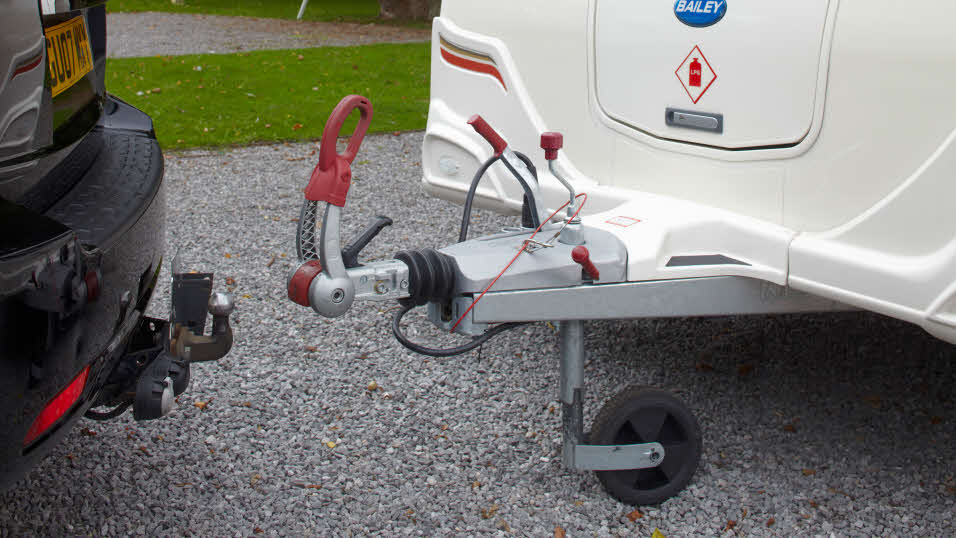More and more caravan users are choosing the detachable towbar, where this rear section including the towball can be readily removed without the use of additional tools, so that the clean lines of the rear of the car can be preserved when it is not towing.
Towball height
In theory, all towbars should set the ball at the correct height.
Make sure that the centre of the towball is between 350mm and 420mm from the ground (when the towing vehicle is fully laden to its gross vehicle weight). This is a legal requirement, so we advise you double check.
When choosing a towbar for an off-road vehicle, ensure that it is either a fixed-height bar similar in height to those made for conventional cars, or a height-adjustable bar which can be set to an appropriate level for on-road towing or off-road driving.
UNECE Regulation 55
UNECE Regulation 55, requires the centre of the towball, when the towing vehicle is fully laden to its gross vehicle weight to be between 350mm and 420mm from the centre of the towball to the ground.
Height of coupling device
For optimum stability the caravan should be level or slightly nose down when hitched and static, and not above level when being towed.
Towball horizontal clearance
Make sure you leave at least 65mm clearance between the towball centre and the nearest vertical part of the vehicle body. This will ensure you meet the EC Directive Regulation 55 (above), this requirement does not apply to off-road vehicles.
Noseweight
Noseweight is the downwards weight the caravan exerts on the back of the towing vehicle when stationary. This is recommended as 7% of the actual laden weight of the caravan. In general this is set by manufacturers at 50 to 80kg, though bigger cars and many 4x4s may offer 100kg or more. We've created a guide on noseweights for anyone who'd like further information on what a noseweight is.
Breakaway cable attachment points
UK law requires that all caravans are fitted with a safety device to provide protection in the unlikely event of the separation of the main coupling while in motion.
Your towbar must have a breakaway attachment point on the towbar mainframe (not detachable neck), this point is ‘snatch-tested’ to ensure reliability. Contact the installer or the manufacturer if you are unable to locate it.
The breakaway cable is designed to apply a trailer’s brakes if it becomes separated from its towing vehicle. Having done this, the cable assembly is designed to part, allowing the trailer to come to a halt away from the towing vehicle.
You should attach the breakaway cable should in such a way that it does not become taut during normal use – even at extremes of steering lock and trailer articulation.
Second-hand towbars
Small ads, online auctions and car boot sales often advertise second-hand towbars. These are potentially dangerous, as you have no way of knowing how they have been used or whether they will fit properly, or even whether all the parts and correct fixings are present. We advise that you should never fit a second-hand unit. If there is already a towbar fitted to a second hand car, get it checked by a competent towbar fitter.
Number plate obstruction
It is an offence to obscure the rear number plate on a car with your towbar or any associated equipment, such as a bumper protection plate. If your towball or any accessory fitted to it overlaps the number plate, it must be removed when you are not towing. Where the height of the number plate means this problem cannot be avoided, consider fitting a detachable towbar, to avoid the difficulty of having to regularly unbolt a fixed towball.
Legal requirements
To establish whether a towbar will meet your needs, it also needs to meet the appropriate European Standards and the manufacturer’s technical specifications.
Cars registered since 1 August 1998 (ie ‘S’ plate) and light commercial vehicles, including vehicles based on light commercial vehicles since 29 October 2012 (ie motorhomes) must fit European type-approved (EC Regulation 5) towbars. Vehicles registered before these dates are exempt.
Most manufacturers market their own approved towbars and some imply that these alone should be used. In reality, car manufacturers cannot object to the fitting of a Type Approved product irrespective of who has made or sold it. Specialist towbar manufacturers such as Witter or Brink will be able to advise on appropriate products for your particular car. You should also ensure that the towbar manufacturer guarantees their product against any damage to the car which is attributable to the towbar.
For older cars and motorhomes, there is no legal requirement to choose a towbar of a particular standard, but our advice is to select one which has been designed and tested to British Standard BS 150 1103:2007 or European Directive 94/20/EC
Motorhomes
Whole vehicle Type Approval introduced for coach built commercial vehicles on 29 October 2012, as such chassis cab based motorhomes registered in the UK after this date require a Type Approved towbar. For motorhomes registered before this date, our advice is as for cars registered before 1 August 1998
 There is a huge choice of towbars designed for towing caravans on the market. Choose wisely to achieve the perfect link between towcar and touring caravan. The modern car design is so complex that the days of buying a towbar ‘off the shelf’ and bolting to the back of your towcar are long gone.
There is a huge choice of towbars designed for towing caravans on the market. Choose wisely to achieve the perfect link between towcar and touring caravan. The modern car design is so complex that the days of buying a towbar ‘off the shelf’ and bolting to the back of your towcar are long gone.